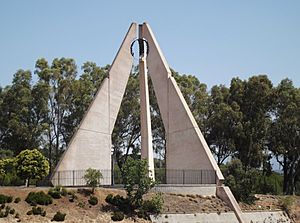Monument to the Battle of Talavera facts for kids
| Monumento a la Batalla de Talavera | |
 |
|
| Coordinates | 39°59′07″N 4°50′51″W / 39.98535°N 4.84752°W |
|---|---|
| Location | Talavera de la Reina, Spain |
| Height | 27 metres (89 ft) |
| Beginning date | 1989 |
| Completion date | 1990 |
| Opening date | 2 October 1990 |
| Dedicated to | Battle of Talavera |
The Monument to the Battle of Talavera is a special memorial found in Talavera de la Reina, a city in Spain. It was built to remember all the soldiers who lost their lives during the Battle of Talavera in July 1809. This battle was one of the most intense and bloody fights during the Peninsular War.
What the Monument Looks Like and Its Story
This monument stands very tall, about 27 metres (89 ft) high, which is like a nine-story building! It has three large shapes made of concrete, each weighing 300 kilograms (about 660 pounds). These shapes look like giant feathers or plumes. Each plume represents one of the armies that fought in the battle: the Spanish, French, and British armies.
At the very top of these plumes, there is a beautiful bronze laurel wreath. A laurel wreath is a symbol of victory and honor. The monument also has the names of the different military groups that fought in the battle carved into its stone.
The Battle of Talavera was very costly. Many soldiers died:
- About 7,268 French soldiers
- About 5,363 British soldiers
- About 1,200 Spanish soldiers
The Spanish government's Ministry of Public Works paid for the monument to be built.
The monument is located on the southern side of a hill called Cerro Medellín. This hill was a very important spot during the actual battle. Today, it stands right next to the A-5 highway.
Building the monument took about a year, from 1989 to 1990. It was officially opened on October 2, 1990. Many important people attended the opening ceremony. These included leaders and military officials from Spain, France, the United Kingdom, Belgium, the Netherlands, Portugal, and West Germany. Some of the well-known people there were Narcís Serra, who was Spain's Minister of Defence, and José Bono, who was the president of Castilla–La Mancha. Ambassadors from several countries were also present.
See also
 In Spanish: Monumento a la Batalla de Talavera para niños
In Spanish: Monumento a la Batalla de Talavera para niños

